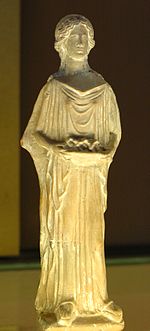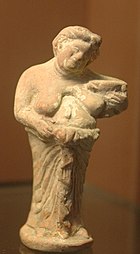Religious functions
Due to their low cost, figurines were widely used as religious offerings. That was their primary purpose, with the decorative aspect coming only later. This explains why the ancient Greek temples host abundant quantities of votive or funerary figurines and why there is almost no document written on their subject.
These figurines can present identification issues. These attributes make it possible to recognize a particular god in an unquestionable way, such as the bow for Artemis. Moreover, certain types of statuettes correspond to a precise form of worship related to a specific divinity. Sometimes, however, "visiting gods" complicate matters: these are figurines dedicated to a god who is not of that sanctuary. In addition, the great majority of the figurines simply represent a woman upright, without attribute. These latter figurines were offered in all sanctuaries, independently of the divinity.
The gift of figurines accompanied every moment of life. During pregnancy, future mothers had care to offer a figurine to Ilithyia, goddess of childbirth: the statuette represents a woman squatting, in full labor, according to the Eastern practice. Certain statuettes include a small cavity intended to receive smaller figurines, representative of their babies. During early childhood, figurines of squatting children were given —a representation of Eastern origin, arrived in Greece via Rhodes and Cyprus. The so-called "temple boys" were thought to protect children. Similar representations are also found in tombs. These figurines are of variable size, perhaps to indicate the age of the dead child. Their habit was to bury the dead accompanied by objects of daily custom: jewels, combs, figurines for the women; weapons and strigils for the men; figurines and toys for the children. Figurines were often voluntarily broken before being placed in the tomb.
The terracotta figurines were often purchased at the entry of the sanctuary. They were the offerings of the common people, who could not afford to dedicate more valuable objects. They were also used to replace offerings in kind, like animals or food. They were placed on the benches of the temples or close to the cult statue. They were also deposited in places of worship outdoors: Socrates recognized a sacred spring on seeing figurines on the ground (Phaedrus 230B). Figurines were dedicated to ask favours from a god as well as to thank him. When the figurines were too numerous in a temple, they were thrown in a "sacred dump". In that case, they are frequently broken to avoid recovery.
Ludic and decorative functions
From the 4th century BC, the figurines acquired a decorative function. They began to represent theatrical characters, such as Julius Pollux recounts in his Onomasticon (2nd century CE): the slave, the peasant, the nurse, the fat woman, the satyr from the satyr play, etc. Figurine features might be caricatured and distorted. By the Hellenistic era, the figurines became grotesques: deformed beings with disproportionate heads, sagging breasts or prominent bellies, hunchbacks and bald men. Grotesques were a speciality of the city of Smyrna, but also produced throughout the Greek world, including in Tarsus and Alexandria.
Tanagra figurines were a mold-cast type of figurine produced from the later fourth century BCE, primarily in the Boeotian town of Tanagra. They were coated with a liquid white slip before firing, and were sometimes painted afterwards in naturalistic tints with watercolors, such as the "Dame en Bleu" ("Lady in Blue") at the Louvre. Tanagra figures depict real women, and some men and boys, in everyday costume, with familiar accessories such as hats, wreaths or fans. They seem to have been decorative pieces for the home, used in much the same way as their modern equivalents, though unlike these they were often buried with their owners. Some character pieces may have represented stock figures from the New Comedy of Menander and other writers. Others continued an earlier tradition of molded terracotta figure used as cult images or votive objects. Typically they were about 10 to 20 centimeters high.
Terracotta was often used for dolls and other children's toys. Examples have been found of articulated figurines or small horses, easy to manipulate for small hands. Sometimes, the nature of a figurine is difficult to determine, such as the curious bell-idols from Boeotia, which appear at the end of the 8th century BC. They were equipped with a long neck and a disproportionate body, cylindrical and lathe-shaped. The arms were atrophied and the legs mobile. The head was pierced with a hole to hang them. It is uncertain if they were toys or votive offerings.




No comments:
Post a Comment